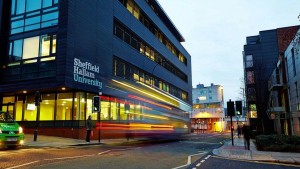I’ve said, and written, before that Hallam is a remarkable place. It is a huge university, with extraordinary things going on in different places. Almost a year in – and I’ll come back to that later in the year – still not a week goes by without my discovering something I didn’t know before. One of the pleasures of writing these blogs is the opportunity they give for me to write about some of those things, and another pleasure now is the conversation, when I walk around the University, or the email which says ‘could you write about something which I am doing in one of your blogs?’.
But, as I have also written before, the University faces some profound challenges. Our National Student Survey results tell us something which other data is already telling us: we have more to do to guarantee a consistently excellent provision for students across the University and support students to secure rewarding employment. In a rapidly-changing higher education market place, we have to be able to re-shape our undergraduate and postgraduate portfolios in ways which attract strong students from the UK and internationally. We have some exceptional research teams and centres, all of them operating in highly competitive fields where research and innovation funding is ever more difficult to secure.
And outside the University, our operating environment continues to change in bewildering ways: a new government, with new priorities; the unpredictable prospect of Brexit and all it might, or might not, mean; a global context for higher education being remade by new regulatory structures, new technologies and more intense competition. It’s a heady mix.
I’ve written all this before and used it to sketch the ways in which the University needs to respond, and, also, to lead in the city, the region and the world. I’ve been clear that our strategy must be compelling and distinctive, shaped by our history and tradition but able to rise to the challenges of new times. I’ve emphasised the importance of universities thinking seriously about the longer-term – important though the next recruitment cycle, research bid, capital investment, budget plan are, they are all most meaningful against a narrative of what the University is for.
When I arrived, several things struck me: first, the centrality of the University to this region, and this city, tracing its origins back to the Sheffield School of Design, established on Glossop Road in 1843. It is important to the lives of people in the city and the region, which means that the obligations on the University to meet their expectations are rightly high. Secondly, the huge commitment of everyone I meet to the University. The third was the remarkable array of things done here: the range, variety and quality, in a fully comprehensive university of 33,000 students and 4500 staff.
At the core of what Hallam does is the idea of impact on the real world: we educate people for useful roles – as engineers and computer scientists, teachers and nurses, social workers and paramedics, artists and lawyers, architects and accountants, and so on; we undertake research which makes a real difference, from materials engineering to sports engineering, to education research and so on and so on. It is an applied university – a university for the real world, not constrained by the seminar room or the lecture theatre. The challenge, in rapidly changing times, is to make the University as outstanding as it can be in pursuing this mission: shaping lives, creating knowledge, leading and engaging locally and globally, enabling change to do things better.
Over the past six months, I have been refreshing the University strategy, working with a small core team of outstanding colleagues – Linda Mason, Deputy Secretary, Tom Russell from the Strategic Planning and Intelligence team and Clare Boot from Business Improvement Services. It’s been a pleasure to work with them. Ideas have been trailed with the Board, explored with the University Leadership Team, raised and considered in various internal groups, including the University Leadership Forum and a Strategy Reference Group, and tested against performance data and against national and global comparators.
In the next week or so, the progress report on a revised strategy narrative and outline will be circulated through faculty, departmental and directorate teams. Eagle-eyed readers of this blog will know that this is a little later than planned – but these things are important to get right. What I now want is your feedback on the analysis of what needs to be done and on the programmes of work envisaged in the strategy. When I came to the University for interview, and then again when I arrived as Vice-Chancellor, I said that Hallam was a good university. Our collective task is to go beyond and make it a truly great university at what it sets out to do.
